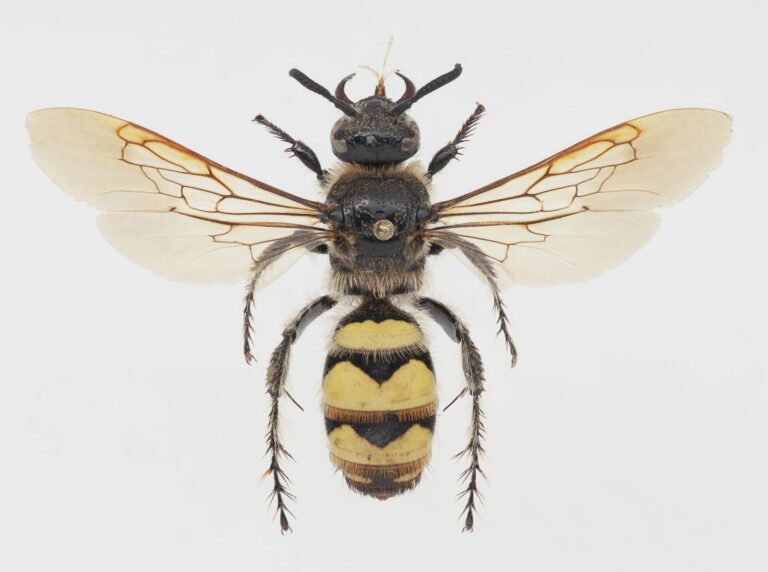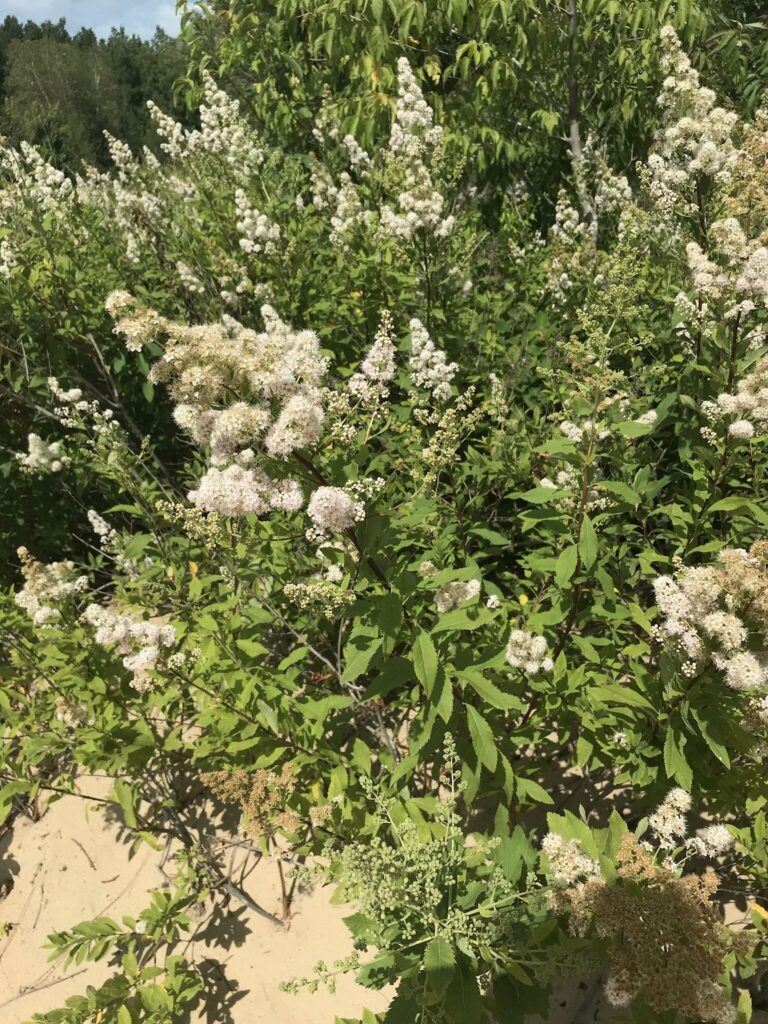
The family Scoliidae, also known as the mammoth wasps, is composed of large-bodied hymenopterans, mostly parasitoids of scarab beetles (Coleoptera: Scarabaeoidea) (Khouri et al. 2022). Almost 600 known species are known worldwide. Although essentially tropical, the group is represented by over 20 species in North America (Osten et al. 2005). Due to their ecology and potential in controlling populations of scarab beetles, many of which are considered pests, several species have been subjected to biological control trials (e.g., Krombein 1948; Abbate et al. 2018).
The members of this family can be identified by their large size (usually over 20 mm) and vibrant coloration (Borror and White 1970), especially in tropical or southern regions. They typically differ from the other families of the former superfamily Vespoidea (now placed within their own superfamily, the Scolioidea (Branstetter et al. 2017)) by the following combination of characters: metacoxae largely separated by the metasternum, which is flat and in the same plane as the mesosternum; propodeum divided by 2 longitudinal grooves; apically wrinkled wings (Borror and White 1970; Brothers and Finnamore 1993). Within its family, the genus Dielis, formerly treated as a subgenus of genus Campsomeris and since elevated to full generic status by Argaman (1996), can be recognized in North America by the combination of two submarginal cells and two recurrent veins in the front wings and white body pubescence (MacKay 1987; Grissel 2021) (Fig. 1). Dielis plumipes, described originally under the name Sphex plumipes by Drury (1770), can be readily identified in Canada, being the sole species occurring in the eastern provinces (Bradley 1928; 1957). The only other species of the genus occuring in Canada is Dielis pilipes (Saussure, 1858), which is only found in the west (Bradley 1928; Nelson and Moffat 2021). D. plumipes is commonly found in sandy and arid environments with sparse vegetation and trees (Fig. 2).
Observations of D. plumipes have been recorded from Ontario for more than a hundred years (Bradley 1928), but none were ever documented in the province of Quebec (Andrew Bennett, pers. comm.). This new occurrence was initially discovered by the first author who captured two specimens in flight among many others in a sandpit in southern Quebec. The specimens, subsequently determined as males, exhibited the same flight behavior reported by Grissell (2021), hovering in figure-8 patterns very close to the ground. The two specimens were sent and deposited at the Canadian National Collection of Insects, Arachnids and Nematodes, where Dr. Andrew Bennett confirmed their identity and the status of a new provincial record. Examination of other private collections from this area revealed more specimens from this general location, captured between 2008 and 2022 by the second author, and a single specimen caught north of the Montreal area by Jean-Benoit Duval. An observation on the website iNaturalist revealed another sighting in southwestern Quebec by André-Philippe Drapeau Picard. Collections data are provided in the attached material, and internet data are provided below.
Internet data: CANADA: Québec - MRC de Pontiac, L’Isle-aux-Allumettes (45.9074, -77.0469), A.-P. Drapeau-Picard, 20.VI.2019, recorded through INaturalist.
The common occurrences of this species in Ontario for more than a century and the discovery of several Quebec localities over the last 16 years suggest a well-established population of D. plumipes in southern Quebec. The fact that such a large insect remained undetected in the province for so long underscores the need for further research and field inventories of wasp populations.
We would like to express our gratitude to Jean-Benoit Duval for providing specimen data and for generously sharing his photograph of the habitus of Dielis plumipes. Additionally, we would also like to thank Dr. Andrew Bennett (CNC) for confirming the species identity and for providing extensive data and valuable information.
Abbate A, Campbell J, Bremer J, Kern WH (2018) The introduction and establishment of Campsomeris dorsata (Hymenoptera: Scoliidae) in Florida. Florida Entomologist 101(3): 543-545. https://doi.org/10.1653/024.101.0334
Borror DJ, White RE (1970) A field guide to insects: America north of Mexico. Peterson Field Guides Vol. 19. Houghton Mifflin Harcourt. New York. 404 pp.
Bradley JC (1928) The species of Campsomeris (Hymenoptera-Scoliidae) of the plumipes group, inhabiting the United States, the Greater Antilles, and the Bahama islands. Proceedings of the Academy of Natural Sciences of Philadelphia 80: 313-337. https://www.jstor.org/stable/4063998
Bradley JC (1957) The taxa of Campsomeris (Hymenoptera: Scoliidae) occurring in the New World. Transactions of the American Entomological Society 83(2): 65-77. https://www.jstor.org/stable/25077743
Branstetter MG, Danforth BN, Pitts JP, Faircloth BC, Ward,PS, Buffington ML, Gates MW, Kula RR, Brady SG (2017) Phylogenomic insights into the evolution of stinging wasps and the origins of ants and bees. Current Biology 27(7): 1019-1025. https://doi.org/10.1016/j.cub.2017.03.027
Brothers DJ, Finnamore AT (1993) Chapter 8. Superfamily Vespoidea, pp. 161-278. in: Goulet H, Huber JT (Eds) Hymenoptera of the World: an identification guide to families. Research Branch Agriculture Canada Publication, Ottawa: I-VII + 668 pp.
Grissell EE (2021) Scoliid wasps of Florida: Campsomeris, Scolia and Trielis spp. (Insecta: Hymenoptera: Scoliidae). University of Florida. Online, accessed 2024-03-27.
Khouri Z, Gillung JP, Kimsey LS (2022) The evolutionary history of mammoth wasps (Hymenoptera: Scoliidae). BioRxiv: 39 pp. https://doi.org/10.1101/2022.01.24.474473
Krombein KV (1948) Liberation of oriental scolioid wasps in the United States from 1920 to 1946 (Hymenoptera: Scoliidae, Tiphiidae). Annals of the Entomological Society of America 41(1): 58-62. https://doi.org/10.1093/aesa/41.1.58
MacKay WP (1987) The scoliid wasps of the southwestern United States (Hymenoptera: Scoliidae). The Southwestern Naturalist 32(3): 357-362. https://doi.org/10.2307/3671453
Nelson TD, Moffat CE (2021) A northern range extension of a Canadian species of special concern, Dielis pilipes (Hymenoptera: Scoliidae), in the Okanagan Valley of British Columbia. BioRxiv: 11 pp. https://doi.org/10.1101/2021.04.27.441674
Osten T (2005) Checkliste der Dolchwespen der Welt (Insecta: Hymenoptera, Scoliidae). Bericht der Naturforschenden Gesellschaft Augsburg 62: 1-62.

Fig. 1. Habitus of a female Dielis plumipes (JBDCDIPL1). Photo by J.-B. Duval.

Fig. 2. Habitat in the Province of Quebec where one specimen (JBDCDIPL1) of Dielis plumipes was captured. Photo by J.-B. Duval.